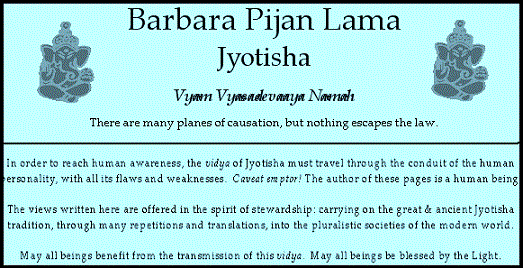
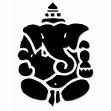
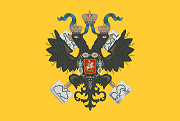
Russian Imperial Flag mid-1800's
Tolstoy's writings on social morality had a profound impact on justice activists, including
-
Satyagraha 1869-1948 Mahatma Mohandas Gandhi
-
God's Dream 1931-1921 Anglican Archbishop Desmond Mpilo Tutu
-
USA Civil Rights 1929-1968 Rev. Martin Luther King
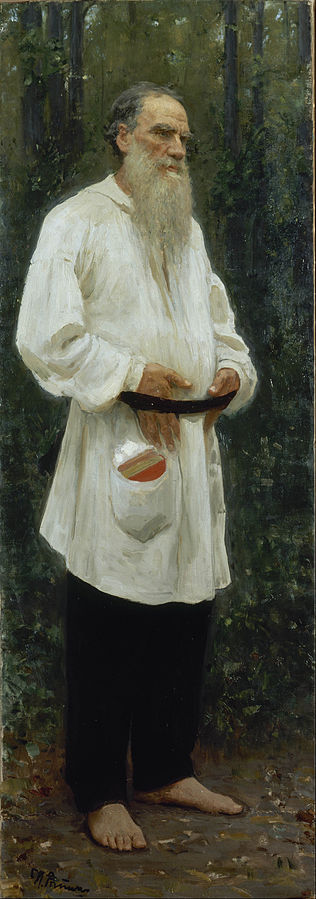
Leo Tolstoy Barefoot by Ilya Repin

Russian novelist
Christian Vegetarian Anarchist
Pacifist Philosopher + Social Justice Visionary
author of War and Peace
https://en.wikipedia.org/wiki/War_and_Peace
Tolstoi, l'homme de la verite
a.k.a. Count Leo Nikolayevich Tolstoy
a.k.a. Lev Tolstoi
Earth-birth Tuesday-09-Sep-1828
dematerialization 20-Nov-1910
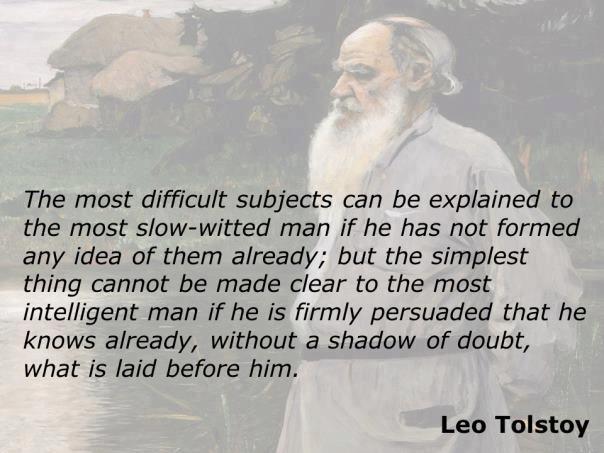
I sit on a man's back, choking him, and making him carry me, and yet, assure myself and others that I am very sorry for him and wish to ease his lot by any means possible, except getting off his back.
~~ Tolstoy , Writings on Civil Disobedience and Nonviolence [1886]
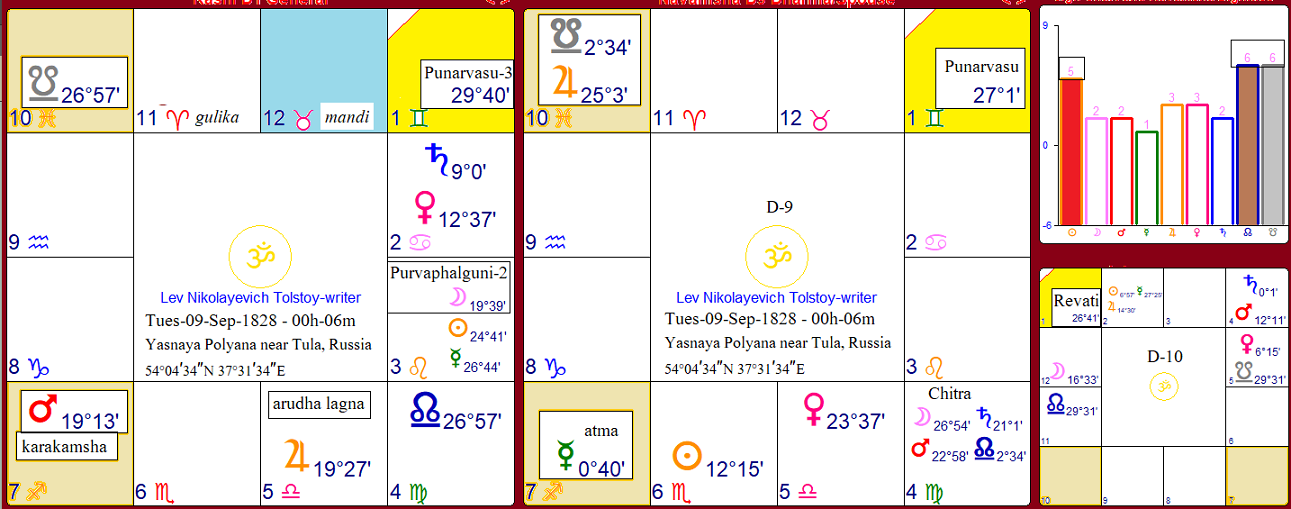
AUTHOR OF War and Peace + Anna Karenina
novelist + essayist
Christian Social Anarchist
1828-1910
Lev Nikolayevich Tolstoi = Leo Tolstoy
birth data from https://en.wikipedia.org/wiki/Leo_Tolstoy
tentatively rectified by BP Lama Jyotishavidya
charts + graphs + tables = generated by Shri Jyoti Star - www.vedicsoftware.com
- adapted by BP Lama
Rising Nakshatra
Masculine Public-Figure Examples
Purnavasi - Vutvrta - Jamitra
BPL COMMENTARY
For Punarvasu births of a masculine valence, the condition of prosperous, preaching, inclusive, broad-scope, philosophical, humanistic Guru may considerably affect the outcome. Masculine births under auspice of Puna, Viśākha, or Pūrvābhādra may find that their worldview is greatly shaped by the character of priestly teachers and guides.
For those born into the Guru-ruled paradigm of Jamitra, teachers, preachers, professors, patrons, agents of generosity and guidance, guru-figures, ideologues, indoctrinators, theorists, know-it-alls, proselytes, pontificators, patriarchs, pandits, prelates, pater-nosters, proponents of principled understanding, wise-ones, wizards, druids, and paradigms of belief may be especially influential.
Guidance is provided by emissaries from the realm of the Twin Gardeners called Castor-and-Pollux. Their purpose is restoration, renewal, and rehabilitation of lost knowledge.
High forehead. Punarvasu often has a global perspective. The majority of Aditya-born nativities are higher dimensional Seva-wanderers who assume interpretive guidance roles.
Instructing, Explaining, describing
[Mithuna - Dvamdva] pada 1-2-3 represents Guru's rulership of 7-agreements ++ 10- leadership, while also expressing the tension between broad-view Brihaspati versus detail-oriented Bantering Budha. Pada 1-2-3 are blessed with an expansive capacity for evocative description or inspirational speaking. Often excellent writers who can facilitate spiritual growth via specific explanation and detailed description. Pada 1-2-3 are often found in the literary arts, in teaching role s, in academic advising, as travel guides, and as poets who describe the natural world.
[Karkata - Kadaga] -pada-4 represents Guru's rulership of 6-imbalance ++ 9-philosophical principles. Pada-4 also embodies the tension between global, paternalistic Saptarishi versus local, undulating, motherly Somana. As master gardeners and natural herbal physicians, they understand the wisdom of the mineral, plant, and animal kingdoms. Pada-4 may also emerge into the religious professions where they may grow a garden of psycho-intuitive understanding that develops into doctrine.
Although the Higher Teacher seeks wisdom, for Karkata-Punarvasu the guru-figure may also be adversarial, impoverished, polluted, or ailing [due to Brihaspati activates 6] .
Themes of restoration of lost knowledge , gardening, fertility of understanding, wish fulfillment, and conceptual teaching may contextualize Aditya's terrestrial experience. Applies also to Chandra in Punarvasu
QUOTATION Punarvasu
from Shil-Ponde [1939] Hindu Astrology Joytisha-Shastra . p 81
" ... from Arudra to Punarvasu, a startling chan ge in mental development.
In Punarvasu, the native is possessed of profound intelligence,
-
capable of delving into and understanding all manner of philosophical and metaphysical postulates.
He revels in abstract thought
-
and has a lively and profound imagination.
He may be also poet of high attainment, expressing a fire and vitality in his verse
-
which is the result of an unusually passionate temperament.
He will, however, be only moderately successful by worldly standards during his lifetime
-
although unlike the Arudra native, he will not experience poverty."
[end quote, Shil Pondey, 1939]
Tolstoy in Midlife
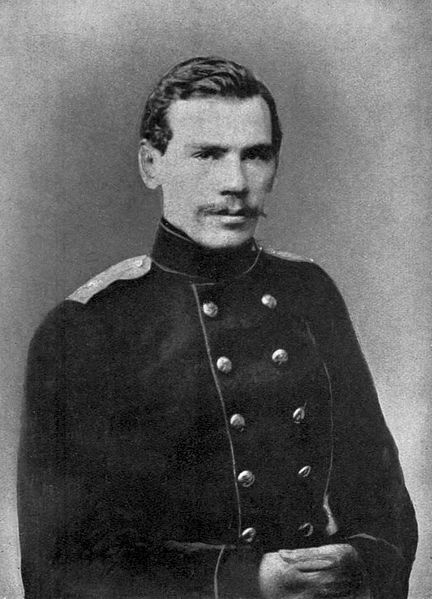
Lev Nikolayevich Tolstoy as a young Russian military officer assigned to the Crimean War, 1853-1856

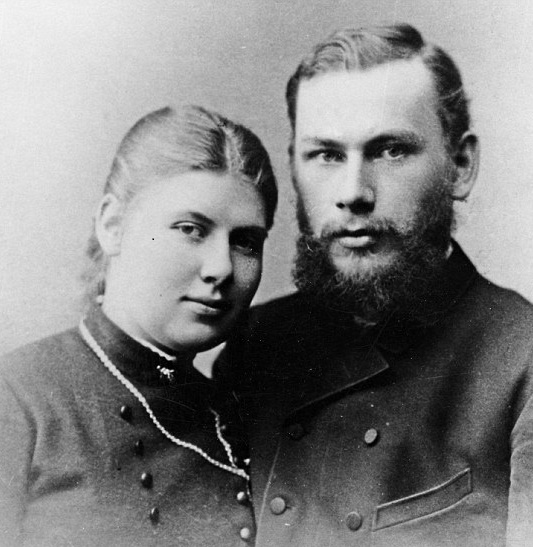
Lev Tolstoi and Sofia Behrs, circa their 1862 marriage.
Leo was 34, Sofia 18 .
Biographical events matched to the Vimshottari Dasha calendar
-
War and Peace 1828-1910 Leo Tolstoy
 [Shukra Mahadasha] =
[age birth until age 10.6]
[Shukra Mahadasha] =
[age birth until age 10.6]
-
[Shukra-Karkata] = [Shukra-2] + [Pushya-Shukra-yuti-Shani-Pushya]
Tues-09-Sep-1828 = Earth-birth in the feudal estate house called Yasnaya Polyana, 54-04′34″N 37-31′34″E = 2-km from Tula, Russia * Shukra-Rahu bhukti
04-Aug-1830 [LNT age 2] grieved the bio-decease of mother * Shukra -Guru bhukti * Guru rules 7th-from-matribhava
21-Jul-1837 [LNT age 9] grieved the bio-decease of father * Shukra -Budha bhukti * Budha rules 2nd-from-Surya
[Surya Mahadasha] = [age 10.6 until age 16.6]
-
[Surya-Simha] = [Surya in bhava-3] + [Pūrvaphalgunī-Surya-yuti-Chandra-Pūrvaphalgunī]
Pūrvaphalgunī-Surya-yuti-Budha-Uttaraphalgunī]
1844 [LNT age 16] begin law studies at Kazan University * Surya-Shukra chidra-dasha * Shukra rules 12-dormitories, distant places
[Chandra Mahadasha] = [age 16.6 until age 26.6]
-
[Chandra-Simha] = [Chandra in Pūrvaphalgunī - Yonī] = [Chandra in classroom-3] + [Pūrvaphalgunī-Somana-yuti-Surya-Pūrvaphalgunī]
Pūrvaphalgunī-Somana-yuti-Budha-Uttaraphalgunī]
1847 [LNT age 19] A frequent patron of local brothels, LNT's 1847 diary entry records treatment for gonorrhea, "obtained from the customary source" * Chandra-Rahu bhukti [Rahu in bhava-4] Kanya, local prostitution
1851 [LNT age 23] joined the Russian Army * Chandra-Budha bhukti * Budha rules-4 defense
1852 [LNT age 24] a letter to his brother records LNT's continuing habit of visiting Kanya ladies and continuing the health woes caused by mercury treatments for venereal infections * Chandra-Budha bhukti * Budha Mercury
Oct-1853 until Mar-1856 [LNT age 25-28] fought through the Crimean War * Chandra-Shukra through Mangala-Rahu bhukti
[Mangala Mahadasha] = [age 26.6 until age 33.6]
1856 [LNT age 28] impulsive trip through Europe, spending richly from a nobleman's budget. LNT diary records the motive as trying to escape the temptations of beautiful serf girls. * Mangala-Rahu bhukti
May-1858 [LNT age 28] diaries record falling in love with the married, suntanned, rustically beautiful Aksinya - a peasant woman bound to LNT's feudal estate * Mangala-Shani bhukti * Shani rules 8 [secrets] in both D-1 and D-9; Shani rules 7th-from-Chandra.
Jul-1859 [LNT age 31] birth of Timofei Bazykin, LNT's son with Aksinya. Count Tolstoy brings Aksinya into his house as a domestic worker, but the child is never acknowledged, * Mangala-Budha bhukti * Budha lagnesha * [Budha-yuti-Chandra] rules 4- household, parenting
20-Sep-1860 [LNT age 32] grieved the bio-decease of confidante elder brother, naikolai * Mangala-Shukra bhukti
1861 [LNT age 33] In a complex and problematic declaration, Russian serfs are formally emancipated * Mangala-Surya bhukti * Surya rules 3-proclamations
[Rahu Mahadasha] = [age 33.6 until age 51.6]
-
[Rahu-Parthya] = [Rahu in bhava-4]
1862 [LNT age 34] starts the revolutionary democratic School at Yasnaya Polyana * Rahu-Rahu svabhukti [ Rahu in bhava-4 ] extraordinary schools
23-Sep-1862 [LNT age 34]
sB age 18] consecration of wedding-2-of-2 with a doctor's daughter, sofia "Sonya" Behrs. LNT arrived an hour late to the ceremony * Rahu-Rahu svabhukti + Rahu-Return
10-Jul-1863 [LNT age 35] child-2 Sergei, with mother Sofie * Rahu-Rahu svabhukti
1870 [LNT age 42] publication of War and Peace * Rahu-Budha bhukti * Budha publication
1878 [LNT age 50] book-form publication of Anna Karenina - Rahu-Chandra bhukti * Chandra-3
[Guru Mahadasha] = [age 51.6 until age 67.6]
-
[Guru-Tula] = [Guru in bhava-5]
1885 [LNT age 57] following six decades of eating a traditional meaty Russian diet, LNT adopts a soup-based vegetarian lifestyle * Guru-Budha bhukti * Budha lagnesha
[Somana-yuti-Budha ] chandra rules 2-food
1891 [LNT age 62] publication of essay, "The First Step" which advocates Vegetarianism. This influential opinion-piece became foundational doctrine for the emerging "Tolstoyan" communal settlements which began forming globally. * Guru-Chandra bhukti * Chandra rules 2-food [Somana-yuti-Budha] writing [Somana-yuti-Surya] ideals
[Shani Mahadasha] = [age 67.6 until decease age 82]
-
[Shani-Karkata] = [Shani in bhava-2] + [Pushya-Shani-yuti-Shukra-Pushya]
1901 [LNT age 73] due to his radical anarcho-pacifist Christian philosophy, LNT is excommunicated from the Russian Orthodox Church * Shani-Ketu bhukti * Ketu excommunication
20-Nov-1910 [LNT age 82] blessed liberation from the Earthen-body, via pneumonia, at Astapovo railway station * Shani-Rahu bhukti
Distinctive Features of the Nativity
-
War and Peace 1828-1910 Leo Tolstoy
[Sparkling Splendid Surya]
pitri-karaka [father] -- jyoti-karaka [light]
= [svakshetra]
[busy-messaging sahaja-pati for Mithuna indriya-lagna]
[bright center of dramatic scripts]
[creative poetic intelligence for writing]
...
[secretive-eruptive Pūrvaphalgunī-4] = [navamsha Surya-Vrischika] confidently discovering-revealing
[Pūrvaphalgunī-Surya-yuti-Chandra-Pūrvaphalgunī]
[Pūrvaphalgunī-Surya-yuti-Budha-Uttaraphalgunī]
-
[Surya-Simha] Khaga * Khagaya - air-moving * brightly charismatic confidence of Center-stage Surya radiates through the regally entitled sparkling displaying game-playing rashi of Surya
-
[Surya in bhava-3] center of commerce * mercantile intelligence * smart reports * dramatic instructional delivery * creative descriptions * sparkling retinue * splendid games of manual-skill * self-referential announcements * admirable handcraft * cinematic genius * smart technology * focus on teamwork * entertaining explanations * administrative entitlements * confident writing * eye on process management * regal messaging * shining star of daily discourse * brilliant gesturing * task-oriented father may be a transactional businessman, clever craftsman, explainer, communicator
-
[Surya-yuti-Chandra] confidently sensitive * bright comforter * entitled to express emotion * radiantly rhythmic * creatively intelligent mother * sensitive to the spiritual rays of the Sun * parents are culturally aligned * patriotic father
-
[Surya-yuti-Budha] confidently conversational * brightly explaining messenger * entitled to discuss * creatively intelligent sibling-cohort * discursive father-figure * gestures conduct the spiritual rays of the Sun * radiantly descriptive * articulate in drama * skillful game-player * self-confident announcements * talks about ideals * narrative of power-politics * recites love poems * describes divine romance
OUTCOMES - MAGNIFICENT MARTANDA
self-reflexively announcing, brightly messaging, intelligently editing, confidently translating, glittering interpretation, regal style of gesture, communicative intelligence, radiantly descriptive, politically collaborative, splendidly explanatory [Surya in bhava-3] rules
-
3-communications, messaging, sermons, scripts, radio-television, media-products, Writing and Publishing, letters of correspondence, announcements, planning, schedules, sales, marketing, documentation, reporting, cohort, entourage, committee-work, iterative stepwise process, manufacturing, commercial business, instruction, explanation, discussion, diagrams, labeling, event management, signage, training, itinerary, tours
CAREER - SPARKLING SURYA
FATHER
Dad = a powerful feudal aristocrat, beholden to no higher authority except the Tsar. The family maintained possession of considerable lands [Chandra] and treasures, was famed and privileged.. Like his son, dad had a significant gambling problem.
[Comfortable Caretaking Chandra]
matrikaraka [mother] -- garha-karaka [village]
[vocalizing dhana-pati for Mithuna indriya-lagna]
- check Surya + Surya-drishti to source Soma's regal feelings, radiating sensitivity, demonstrative habits
[politically comfortable with poetic cohort]
[familiar with delightful entertainment messaging]
[needs to communicate about romantic feelings]
[soothed by bright displays of ensemble collaboration]
[profoundly fluctuating entitled mentality]
[regal mother may be fashionable businesswoman or creative writer]
[mom's intelligence reflects the father's will]
...
[analytical-helping Pūrvaphalgunī-2] = [navamsha Chandra-Kanya] intuitively sensitive ministry criticizing complaining feelings
[Pūrvaphalgunī-Somana-yuti-Surya-Pūrvaphalgunī]
[Pūrvaphalgunī-Somana-yuti-Budha-Uttaraphalgunī]
-
[Chandra-Simha] comforted by creative display * settled into dramatic rhythms * needs attention
-
[Chandra in Pūrvaphalgunī - Yonī] soothed by sparkling luxury * protectors of musical entertainments * needs brilliant beauty * feels entitled
-
[Chandra in classroom-3] comfortable with cohort-collaboration * familiar with interactive communication * calmed by repetitive announcements * feels the tidal pulse of daily chat * feels sheltered in the parlor * soothed by siblings * intuitive information delivery * settled into the habits of writing * needs continuous commerce * accustomed to routine messaging * emotionally attuned to the rhythms of conversation * undulating signals * ethno-cultural gestures * intuitive handcraft * mother may be a manager, administrator, shopkeeper, craftswoman, publisher
-
[Somana-yuti-Surya] emotionally entitled * sensitive to fatherly folk * needs sparkling centrality * sentimentally romantic * creative mother * comforted by confidence * undulating intelligence * soothed by attention * calmed by applause * feels like royalty
-
[Somana-yuti-Budha] emotionally communicative * sensitive to sibling figures * sheltered by workmates * calmed by a chatty cohort * talkative mother * needs to evangelize * makes empathetic gestures * soothed by conversation * feels like a messenger
OUTCOMES - ANCESTRAL SOMA
sensitively talkative, protectively managing, routinely interactive, parentally explanatory, rhythmically scripted, conducts customary commerce, predictable teamwork, culturally neighborlike, emotionally collaborative, needs to describe and signal [Chandra in classroom-3] rules
- 2-acquisition, family legacy, tradition, language-lexicon, preserved memory, banking, collections, entreasurement, herd-hoard, treasury containment, financial capital, accrued amounts, asset evaluation, knowledge of history, speech-song, heritage values, color-sound, arts-and-music, face-voice-eyes-teeth-mouth-hair, genetics, stored resources, health of the father
CAREER - CARETAKING CHANDRA
- [folk-reputation 10th-from-Chandra = habitual public duties are conducted via Urisha-12. Known for capitalizing, knowledgeable, storytelling, singing style of interiority, imagination, research, meditation, enclosure]
[Chandra in Pūrvaphalgunī - Yonī] a great attraction to beautiful ladies and specific diary descriptions of the yoni experience
MOTHER
Mom = Mariya Nikolayevna, born as Princess Volkonskaya. [Chandra-Simha]
yuti Surya] shows her entitlement. Mom died when young Leonid was 18 months old.
LNT's care passed to his father, who died seven years later.
MARRIAGE partnership emotional equity support expectations
Two marriages are expected due to [Shukra-yuti-Shani]
[7th-from-Chandra-3] marriage 1-of -2
LNT's first child was Timofei Bazykin, born to a serf woman. Aksinya Bazykin, the child's mother, was classed in the feudal hierarchy as a piece of property belonging to LNT's family's estate.
Despite her collectivist identity [Kumbha] Axinya maintained a relationship with Tolstoy while raising their son.
marriage 1-of -2 = parenting-partnership-1 with serf Aksinya
-
[Shukra-yuti-Shani] two wives. Shani [base-class] holds the lower degree, which identifies Aksinya as the first wife
- Although legal equality was impossible, reputedly LNT remained in personal contact with Aksinya, and their shared son. until her death.
- [this continuing relationship is evidence that Chandra occupies Simha, not Kanya, because 7th-from-Kanya would hold the dis-continuous Ketu]
8th-from-[7th-from-Chandra-3] = [2nd-from-Chandra] marriage 2-of -2
-
[Shukra-yuti-Shani] two wives. Shukra
[valued-class] holds the higher degree, which identifies Sophie as the second wife
- Sophie Andreevna Berens [Behrs] was a woman of aristocratic [German] lineage, approved by LNT's class-conscious family [2]
Shukra-2 [wife-2] rules Guru-5 creative writing
- Sophie Behrs was a dynamo of the Word and the Lineage
- She vigorously promoted Tolstoy's literary career.
Sophie [her name Russianized to Sonya] bore thirteen children into the union, even while also she copy-edited and prepared the manuscripts of LNT's increasingly famous literary works [5].
- Forensic literary analysis suggests that Sophie did considerable original writing as well.
- While LNT dictated his ideas, sonya was the transcriptionist.
- Listening to LNT's direct speech, sonya Tolstaya composed many of his manuscripts.
- For the manuscripts that LNT produced himself, sonya re-wrote his manual edits, and prepared the copious manuscripts as clean-copy for the publisher.
2nd-from-Chandra
[emotional condition in alliance-2] contains [Rahu in bhava-4] ruled by Budha-publications
- While LNT mused, walked, and wrote, land-owning Sofia Behrs [Rahu in bhava-4] managed LNT's substantial feudal estate containing hundreds of serfs and their working children.
It is safe to say that without the decades-long dedication of his educated, literary wife, there would have been no Tolstoy oeuvre.
Eldest child = 5th-from-Chandra
- son of LNT with serf Axinya = Mangala-7-Dhanus, ason
Mangala rules 6 + 11 +++ 4th-and-9th from Chandra
LNT sired his first child with a the serf Aksinya
- LNT's eldest son acquired his mother's social rank as permanent servant [serf] bound to the land
- The son was raised as a serf with no property entitlements and no right to exit the boundaries of the estate on which he was born.
Three years later, tolstoy married a woman of aristocratic rank, sophia
[Sonya] Behrs. The 13 aristocratic children that were born to LNT and Sonya Tolstaya would have legally inherited their father's treasuries and landed property.
[Competitive Champion Kuja]
bhratru-karaka [brother] -- virya-karaka [virility]
[inimical-medicating rogesha for Mithuna indriya-lagna]
[profitable-connected labha-pati for Mithuna indriya-lagna]
- check Guru + Guru-drishti to source Kuja's vitally principled, enthusiastically pushy, doctrinally guided actions
[actively inspirational ways of friendly marketplace earning labha-pati]
[catechetical pursuit of contractual equity]
[aggressively exploitive dogma-driven inimical deal-making rogesha]
[uplifting energies may motivate brokered alliances]
[forward-pushing indoctrination via lively arrangements]
[advisors may recommend use of principled agreements]
[profits from ideological warfare labha-pati]
[attracted to faith-based sexual pairings]
[pioneering priestly force seeks gainful labha-pati negotiated trust]
[believing partner has cheerfully jovial brotherly qualities]
[faithful partner may mistreated philosopher, drug-using optimist, servant of patriarchs, global profiteer, preaching engineer]
...
[argumentative-helping Pūrvāṣāḍhā-2] = [navamsha Mangala-Kanya]
-
[Mangala-Dhanus] vigorous development of humanistic worldview * energized inspiration * thrust toward doctrinal expansion * proactive teaching-preaching * promotes philosophical globalism * champion of broad understanding * pursues patronage
-
[Mangala in bhava-7] drive toward bargaining * pursuit of agreement * impatient with stagnant arrangements * invasive negotiation * diplomatic dynamics * energized contracts * innovative conquests * pushes toward liaison * invigorates alliances
OUTCOMES - MOVING MANGALA
competitive bargaining, self-promoting negotiator, pursues agreements, aggressive match-making, dynamic adjustment, fights for justice, forward-pushing diplomacy, conquering warrior in relationships, dominating advocacy, pro-active work in lawcourts, energetically innovative arrangements, champion of pioneering new harmonies [Mangala in bhava-7] rules
-
6-ministries of service, dehumanization, misconduct, war, jail, slavery, pollution, argumentation, healthcare workers, ailment, injury, medical treatment, hypocrisy, crime, cheating, animosity, toxins, complaints, accusation, litigation, blaming, scapegoat, aid workers, helpers. imbalanced conditions, injustice, betrayed promises, servants, laborers, hostility, animosity, disagreement, dehumanization
-
11-fruitful revenues, interconnected income, profits, material achievement, social networking, friendships, community linkage, fan-clubs, mass participation gatherings, collectivism, marketplace gridworks, distribution, association, populism, economic systems, fundraising, gains-and-goals, awards for work accomplished, health of the enemies
CAREER - COMPETITIVE KUJA
[Busy Bantering Budha]
jamayah-karaka [sibling] -- sandesha-karaka [message] -- shisya-karaka [student]
= [svabhava]
[energizing-identifying lagnesha for Mithuna indriya-lagna]
[homebound-anchoring bandhesha for Mithuna indriya-lagna]
- check Surya + Surya-drishti to source Budha's willful dialogs, solipsistic interpretations, center-stage discourse
[dramatic sparkling detailed communications]
[writes articulately about self-awareness]
[political evangelism]
[confidently describes idealistic romance]
...
[dogmatic-believing Uttaraphalgunī-1] = [navamsha Budha-Dhanus]
[ātmakāraka writing, descriptions, instructions, messaging, publication, travel itineraries]
+ [Uttaraphalgunī-Budha-yuti-Surya-Pūrvaphalgunī]
+ [Uttaraphalgunī-Budha-yuti-Chandra-Pūrvaphalgunī]
-
[Budha-Simha] political communications * articulation of unique creativity * delivers celebratory announcements * manufacturers bright displays * explains celebrity entitlements * romantic messages * declares poetic adoration * delights in glittering phrases * manages entertainments * details the procedure for theatrical amusements * speaks with royal flamboyance * talks about gambling * plays intelligent games * hands-arms-shoulders send dramatic gestures
-
[Budha in bhava-3] narrative of cohort collaboration * chatty siblings * articulate announcements * discusses commerce * instructions for management * conversations about information technology * clever programming * logical reporting * talks about daily business * handles information * skillful printing * scripted dialog * text instructions * writes lyrics * detailed media-messaging * communication tactics * explains marketing * quick manufacturing * descriptive process * signaling gestures
-
[Budha-yuti-Surya] amusing explanations * entertaining chatter * central roles in communication * brightly clear descriptions * dramatic enunciation * confidently delivers instruction * articulation of radiant certainty * political messenger * talkative father-figures
-
[Budha-yuti-Chandra] explainer of feelings * mentalized caretaking * communicative parenting * familiar rhythmic phrasing * ancestral instruction * writes sensitive speeches + songs * soothed by scheduling * sensitive merchandising * needs to plan * describes the comfortable routines * responsive siblings * intuitively talkative mother
OUTCOMES - BANTERING BUDHA
commercially adept, administratively detailed, skilled manager, articulately gesturing, descriptive writer, mercantile mentality, cohort communicating, committeeworker, defining announcer, specific explanations, chatty conversations, handcraft manufacturing, neighborly meeting [Budha in bhava-3] rules
-
1- distinctive attributes of personality, dense material incorporation, individual personification, earthen embodiment, physical integrity, kinetic energy, dance, style of movement, athletic prowess, muscular mobility, unique character, kinetic vitality, circumstances of birth, forward push, tangible appearance, coherent social identity
-
4 cultural foundations, property boundaries, way of Life, protection, defense , homeland, household, routines, rituals, mother, parents, customary rhythms, caretakers, socialization schooling, gardens, waterways, transportation, housing, social security, sense of place, environmentalism, citizenship, belonging, ethnic basis, ethno-religion, patriotism, real-estate, farming, land-ownership, burial, predictability, health of the elder sibling
CAREER - BUSY BUDHA
[Budha-Simha] = [Budha in bhava-3] + + [Uttaraphalgunī-Budha-yuti-Surya-Pūrvaphalgunī] + [Uttaraphalgunī-Budha-yuti-Chandra-Pūrvaphalgunī]
- LT wrote extensively about the tension between the orderliness of the strict social-caste hierarchy, versus the aesthetic of equity and fairness between aristocrats and serfs, in traditional Russian agricultural estates [Karkata farms]
[Budha in bhava-3] rules
- 1-personality, physique, appearance, mobility
-
4-lands-and-properties, parentage, foundational education, customary routines
Celebrated writer of a deeply ethnic genre [Rahu-4].
Despite numerous contradictions in his lifestyle and philosophies, tolstoi was almost universally hailed as a superb elucidator of the Russian social consciousness, and his reputation in subsequent centuries was not diminished.
[Generous Growing Guru]
dhava-karaka [husband] -- bahuta-karaka [variety]
[bargaining-adjusting jaya-pati for Mithuna indriya-lagna]
[dutiful-commanding karmesha for Mithuna indriya-lagna]
- check Shukra + Shukra-drishti to source Guru 's wisely compromising, expansively diplomatic, charitable adjustability
[generously diplomatic globalist intellect]
[gracefully balanced large scale public showmanship]
[confidently contractual financial speculation]
[broadly tolerant brokerage of legal agreements]
[harmonious displays of negotiated relationship]
[benevolently equable theatrical performance of arranged roles jaya-pati]
[entitled, socially approved karmesha celebrity children enjoy fairly played games]
[pleasant diversity of romantic alliances] [wide-scope inclusive dealings in trade and treaty]
..........
[visionary-guided Arcturus-4] = [navamsha Guru-Meena] intuitively expansive social-justice charitable visionary imagination
-
[Guru-Tula] many trades * variety of exchanges * optimistic negotiations * believes in justice * doctrine of contractual exchange * multiple alliances * permission to bargain * propagation of treaties and trusts * diversity of arrangements * equable guidance * widens the scope of balanced design
-
[Guru in bhava-5] much creativity * many intelligences * many entitlements * numerous games * diverse entertainments * many romances * extensive self-glorification * children identified with paradigmatic beliefs * expansion of political display * development of drama * optimistic in speculations * patron of creative performance * in a wifely nativity, husbandly-companion may be a game-player
OUTCOMES - GENEROUS GURU
abundantly celebrated, inspirationally center-stage, jovially entertaining, tolerant genius, globally creative, divinely guided gambling, confidently speculative, believes in romance, idealistic indoctrinator [Guru in bhava-5] rules
-
7-covenant, promise, trust, contractual relationships, social justice, advocacy, legal judgments, lawcourts, appeals, representation, equity, diplomacy, partners, justice, marriage, legal and formal partnerships, negotiation, alliance-crafting, match-making, fair arrangements, even deals, advocacy, trading, bargaining, brokerage, haggling, go-between, middleman, meddler
-
10-career, profession, dignity, regulatory roles, governance duties, social authority, symbolic recognition, iconic visibility, leadership responsibility, top status, reputation, commanding positions, honor, high regard, public respect, executive power, elite rank, lawful imposition, organizational director
CAREER - BENEVOLENT BRIHASPATI
Guru rules kārakāmsha Dhanus-7 beliefs about equity, justice, judgments, legal standing
[Sweetly Suave Shukra]
svadu-karaka [sweet] -- kalatra-karaka [wifely companion]
[witty-speculative vidya-pati for Mithuna indriya-lagna]
[retreating-contemplative vyaya-pati for Mithuna indriya-lagna]
...
[bargaining-contractual Pushya-3] [navamsha Shukra-Tula]
+ [Pushya-Shukra-yuti-Shani-Pushya]-
[Shukra-Karkata] values comforting routine * likes to nourish * attracted to settled habits * prefers a home-loving partner * taste for folk-lifestyle * appreciates farmers-and-fishers * pleased by secure borders * enjoys rhythmic seasons * adorns beautiful gardens * seeks balanced parenting arrangements * aesthetic of domestic sharing
-
[Shukra-2] = [svabhava] seeks pleasure via gathered treasuries * enjoys banked assets * bargains toward collected equity * feminine-figures predominate the family * gracious storyteller * pretty preservations * balanced linguistic expression * beautiful voice * pleasing designs to adorn the face * aesthetics of mouth + jaw + teeth + hair * graceful neck * prefers historical values * appreciation of speech-and-song * for husbandly nativity, wifely-companion may be banker, collector, historian, preserver
-
[Shukra-yuti-Shani] sweetly serious deal-making * mature relationships * graciously responsible * beautiful bones * appreciation for neutrality * strict negotiations * pleasant legal mediation * rigorous bargaining * enduring agreements * regulated contracts * architectural elegance * pragmatic design * lawful arrangements * realistic finance * prefers relationships with orderly partners * for husbandly nativity, preference for seasoned, class-conscious partners
OUTCOMES - SWEETENING SHUKRA
sensually acquisitive, appreciates artistic traditions, harmoniously speaking, historical aesthetics, finances from mother-and-father, lovely eyes, musical feminine-figures, beautiful collections, family-based relationships Shukra-2] rules
-
5- Politics, center-stage roles, theatre, demonstration, display, charming brilliance, genius, poetry, choice-making, showmanship, gambling and gamesmanship, romantic idealism, creativity, fashion-shows, flamboyance, celebrity entitlements, confidence, artistic performance, drama, children, financial speculation, intelligence, entertainments, fun
-
12 enclosures, the bed, fantasies, privacy, interior spiritual guidance, clandestine undertakings, intuitive awareness, non-linear conceptual undertanding, concealment, seclusion, invisibility, dissolved identity, meditation, contemplation, dreamworlds, astral plane, imaginary scenarios, sanctuary sleep, distant lands, distress of the avowed partner
CAREER - BRIGHT BHRIGU-TANAYA
[Shukra-yuti-Shani] suggests two wives.
- Axinya. The mother of Tolstoy's first child. She was a serf on LT's family's land.
- With his legal wife and literary assistant Sophy Behrs, LNT produced 13 additional children.
[Sober Structural Shani]
duro-karaka [endurance] -- jara-karaka [Jahre, years]
[mysterious-discovering randhresha for Mithuna indriya-lagna]
[doctrinal-preaching dharmesha for Mithuna indriya-lagna]
- check Chandra + Chandra-drishti for Shani's comfortably unyielding, unmovingly established, protective rule-based ordering
[culturally limited distribution of family assets]
[strictly traditional household routines]
[ancestral memories filtered through rigid seasonal rules]
[socially regulated truth-telling about ancient secrets randhresha]
[speaks cautiously about patriotic defense]
[staunch protector of folkways belief dharmesha]
[obligatory hesitant truth-telling about ancient secrets randhresha]
[speaks cautiously about patriotic defense]
[habitual fear of innovation to historic rituals]
[must maintain parental structure of social ordering]
[elders restrict change to agricultural heritage]
[sheltering elders may require the preservation of nourishment values of local worship and water storage]
...
[argumentative-calculating Pushya-2] = [navamsha Shani-Kanya] intuitively ordering class-conscious analysis argument complaint
+ [Pushya-Shani-yuti-Shukra-Pushya]
-
[Shani-Karkata] overburdened routines * class-conscious ethnicity * habitual conformity * must accept social responsibility for emotional stability * old defensive structures * structural compression upon stomach * strict security systems * proletarian cultural roots * must continue orderly sustainable settlements * rigid resistance to change of the folkways * regulates farming-fishing habits * must care for elders * aging local infrastructure * cramped shipping ports * ancient roadways * agricultural drought * dark dwellings * often stuck in a rut * protective policing routines * scarce domestic resources * maintainer of old seasonal rhythms
-
[Shani in bhava-2] steady time-structured values-fulfillment * scarcity of precious resources * must preserve historic traditions* must gather * must catalog * obstructionist family-of-origin * must remember * cautious use of words * boney face * tense eyes * class-conscious speech * speakers' fatigue * chronic financial insufficiency * undernourished eye-teeth * must use old libraries * cold dried food hoard * limited sight * ossified heritage * language regulator * appreciates ignorance * maintains treasuries of proven knowledge * hierarchies impose know-nothing rules * elders hold center of family
-
[Shani-yuti-Shukra] slow system imposes lawful equity * limited luxuries * sturdily handsome * orderly feminine figures * pragmatic finance * persistent steady negotiation * contractual discipline * socially constrained harmony * conventionally regulated pleasures * trust in age * mutuality over time * class-structured arrangements
OUTCOMES - STRUCTURAL SHANI
obliged to family heritage, cautious speech, naarratives of duty, financial responsibility, has to conserve natural resources, oppressed by old vows, mature evaluation, collects valuable old artifacts, limited food, must preserve secret treasuries, must regulate the lineage assets, structured style of singing, slowed [but not prevented] acquisition of enduring pleasure, burdensome historical precedent, family-of-origin may impose heavy restraints [Shani in bhava-2] rules
-
8-unexpected eruptions of regenerating force, occult initiation, mystical revelation, shocking intervention, opaque empowerments, invasive surgery, intensive healing, evolution, violent explosion, sudden identity change, rejuvenation, recycling, rebirth, hidden assets, upheaval, undisclosed secrets, transformative events, discovery, in-laws of first marriage, health of younger sibling-cousin
-
9-ideology , paradigm of belief, profession of faith, principled convictions, higher understanding, father-figures, priestly patronage, preaching, patriarchal entitlements, philosophical convictions, theory, public spiritual guidance, celebrated doctrines, sangha, sacred teachings, credenda, globalism, dharma, worldview, weltanschauung, mother's health
CAREER - SOBER SHANI
traditional, serious-speaking, strictly remembering, hoarding, resource-scarce, financially cautious [Shani in bhava-2
[Risk-rewarding Rāhu]
rajyalobha-karaka [ambition] -- picchala-karaka [slippery]
[for Mithuna indriya-lagna]
[Rahu-4 casts passionately property-owning habitual drishti into 8-10-12]
...
[analytical argumentative Chitra-2] = [navamsha Rahu-Kanya] = [vargottamsha]
-
[Rahu-Parthya] shimmering illusion of humility * craving for crime * mask of exploitive assistance * ambitious physicians * intriguing addictions * mirage of medication * fascinating injuries * over-reaching accusations * amazing illnesses * extraordinary arguments * may be obsessed with servants-and-servitude * seeks special importance via apparent [but perhaps not authentic] conflict management * shrewd dealings in sickness * ingenious divorce * extravagant litigation * seeks privilege via victim-roles
-
[Rahu in bhava-4] passion for prestige property * unusual home routines * exotic roots * in svabhava of Comforting Chandra, the Shadowy Specter seeks homestead advantage * outsider who cleverly insinuates into the local settlement * culturally-mixed kitchens * fascinating vehicles * extraordinary ships * glamorous guardianship * important infrastructure * irregular land-use * over-reaching protectionism * exciting real-estate * expedient nationalism * instrumental environmentalism * unorthodox parenting * trespasses customary seasonal limits * disrupts habitual agriculture * over-extended fencing * Strange traffic on roadways * craves a showcase home * marvelous gardens * desires fabulous shelters * ambitious mother * social mobility sought via patriotism
OUTCOMES - RISK-REWARDING RAHU
Rahu occupies the Arudha lagna-5 indicating creative literature, politics, drama, children, genius
[Collapsing unshackling Ketu]
kavandha-karaka [headless] -- chidra-karaka [gaping] -- vasana-karaka [vacuum]
[for Mithuna indriya-lagna]
[dispersed engagement with otherworldy leadership]
[dissolution of commanding visionary positions]
[restlessly anarchic toward high-ranking contemplative roles]
[may abdicate a top interior-guidance position]
[surrenders useless invisible authority]
[apatheticly forgives the trespass of social-ordering dreamers]
[abandons unsustainable isolation]
[absent from empty state-regulated enclosures]
[disregards obsolete respected spiritual conventions]
[widely-known eccentric meditations may symbolize dematerialization of the regime ]
[reputation for erratic clairsentience and claircognizance]
[has the sanctuary space and the status, but walks away from public empowerments]
[may be passively fixated upon ambitiously exploited, ministering-assisting Rahu in Partha-4 parents, householders, property-owners, gardeners, stewards of Earth]
...
[imaginative-charitable Revatī-4] = [vargottamsha] [navamsha Ketu-Meena]
-
[Ketu-Meena] sleepily dissociates from isolated ashrama * incomplete gestalt * unlimited visionary insight * wandering spirit guides * unsustainable sanctuary * fantasy martyrdom * dissolution of private prayer * foggy boundaries of distant worlds * permeable understanding of cetacean cultures * ignores restrictions on clairsentience and claircognizance * disarrayed dreams * releases a golden oceanic cloud of wisdom into the misty abyss
-
[Ketu in classroom-10] disregards social rank * no barriers in class-pyramid * fearless toward regulations * martyr to corporate elites * well-known for surrendering * absent from officialdom * irrelevance of government protocols * ambivalent toward public opinion * disinterested in high positions * ignores hierarchical ordering rules * abandons organizational authority * unless other graha in 10, may prefer to live free from heavy leadership duties
Tolstoy's public reputation [Ketu in classroom-10] came from his understanding of his serfs and their way of life.
LNT was famed for his principled development of Christian Social Anarchism . He promoted abdication of class-entitled privileges.

[How Readings Work] = [Sample Sacred Jewels Ratna Recommendation] = [Seva]
file update =
17-Nov-2025

[Copyright 1994-2094 by Barbara Pijan Lama] = [Contact] = [How to Request a Jyotishavidya Reading]
Barbara Pijan Lama Jyotishavidya Vedic Astrology Surya Sun Chandra Moon Mangala Mars Budha Mercury Guru Jupiter Shukra Venus Shani Saturn Rahu Ketu Graha Planets Dasha Timeline Nakshatra Navamsha Marriage Children Wealth Career Spirituality Wisdom Cycles of re-Death and re-Birth
The information on barbarapijan.com , including all readings and reports, is provided for educational purposes only. Wishing you every happiness and continuing success in studies!
all that is true, all that is noble,
all that is just and pure,
all that is loveable and gracious,
whatever is excellent and admirable -
fill all your thoughts with these things."
~~ Paul of Tarsus, Epistle to the Philippians 4:8